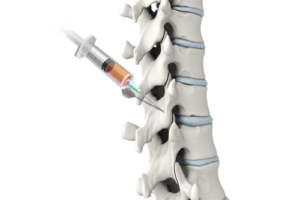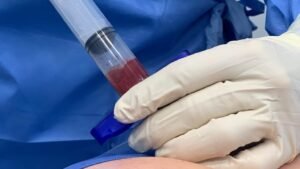Introduction
Low back pain is a prevalent and often debilitating condition that can significantly impact a person’s quality of life. While surgery is sometimes necessary for certain back conditions, many individuals prefer non-surgical alternatives due to their lower risk and less invasive nature. This article explores seven promising non-surgical treatments for low back pain, backed by evidence from published articles and medical journals.
Platelet Rich Plasma (PRP) Injection
Platelet-rich plasma (PRP) therapy is an emerging treatment for low back pain that utilizes the body’s natural healing properties. PRP is derived from the patient’s blood and contains a concentrated mix of platelets, growth factors, and cytokines. These substances play a crucial role in tissue repair and regeneration.
Several studies have shown promising results for PRP injections in the management of low back pain. A study published in the Journal of Orthopaedic Surgery and Research (2019) demonstrated that PRP injections significantly reduced pain and improved function in patients with chronic low back pain. (1)PRP may promote tissue healing, reduce inflammation, and stimulate the regeneration of damaged spinal tissues.

Prolotherapy
Prolotherapy, also known as regenerative injection therapy, involves injecting a solution, typically containing dextrose and lidocaine, into the affected area. The goal is to stimulate the body’s natural healing response by creating controlled inflammation.
Multiple studies support the effectiveness of prolotherapy for low back pain. A systematic review and meta-analysis published in the Journal of Alternative and Complementary Medicine (2016) found that prolotherapy was associated with significant pain reduction and improved function in patients with chronic low back pain.(2)Prolotherapy may strengthen ligaments and tendons, providing stability to the spine.

Treatment Injections
Botulinum toxin, commonly known as Treatment, has gained attention as a potential treatment for chronic low back pain. Treatment injections work by blocking nerve signals in the targeted muscles, reducing muscle spasms and pain.
Research published in the European Journal of Pain (2017) investigated the efficacy of Treatment injections for low back pain and found that patients experienced significant pain relief and improved function.(3)Treatment may be particularly useful in cases where muscle spasms contribute to back pain.
Stem Cell Therapy
Stem cell therapy is an innovative approach that aims to regenerate damaged tissues in the spine. Mesenchymal stem cells, which have the potential to differentiate into various cell types, are often used in these treatments.
Numerous studies have explored the use of stem cell therapy for low back pain. A study in the European Spine Journal (2015) reported that intradiscal injection of mesenchymal stem cells resulted in pain reduction and improved disc hydration in patients with degenerative disc disease.(4)Stem cell therapy holds promise for promoting tissue repair and addressing the underlying causes of low back pain.

Epidural Steroid Injections
Epidural steroid injections (ESIs) are a well-established non-surgical treatment for low back pain. They involve the injection of corticosteroids into the epidural space surrounding the spinal cord. These injections can provide significant pain relief by reducing inflammation around nerves and spinal discs.
Research published in the Journal of the American Medical Association (2014) indicated that ESIs were effective in reducing pain and improving function in patients with radicular pain due to disc herniation. While ESIs may not address the root cause of the pain, they can provide valuable relief and allow patients to engage in physical therapy or other rehabilitative measures.
Radiofrequency Ablation
Radiofrequency ablation (RFA) is a minimally invasive procedure that uses heat generated by radiofrequency waves to target and disable specific nerves responsible for transmitting pain signals. This procedure can be effective for treating facet joint pain and sacroiliac joint pain.
A systematic review published in the European Journal of Pain (2017) found that RFA provided significant pain relief in patients with chronic low back pain originating from the facet joints.
RFA can offer long-lasting relief and improve the quality of life for individuals suffering from this type of pain.
Ozone Therapy
Ozone therapy involves injecting ozone gas into the affected area, and it has gained attention as a non-surgical treatment for low back pain. Ozone may have anti-inflammatory and analgesic properties, making it a potential option for pain management.
A study published in the International Journal of Spine Surgery (2018) investigated the use of ozone therapy for patients with lumbar disc herniation and reported significant pain reduction and improved functional outcomes. While more research is needed to establish its long-term efficacy, ozone therapy offers a non-invasive option for some individuals with low back pain.
Conclusion
Low back pain is a complex and multifaceted condition that can significantly impact an individual’s life. Fortunately, there are non-surgical alternatives that show promise in providing relief and improving function for those suffering from this condition. Platelet-rich plasma (PRP) injections, prolotherapy, Treatment injections, stem cell therapy, epidural steroid injections, radiofrequency ablation, and ozone therapy are among the options backed by research and medical literature.
It’s essential for individuals with low back pain to consult with Healthcare Experts such as AT ALLEVIATE, to determine the most appropriate treatment based on their specific condition and needs. Non-surgical treatments offer hope for many individuals seeking relief from low back pain without the risks and recovery associated with surgical interventions.
REFERENCES
- Hong M, Cheng C, Sun X, Yan Y, Zhang Q, Wang W, Guo W. Efficacy and Safety of Intra-Articular Platelet-Rich Plasma in Osteoarthritis Knee: A Systematic Review and Meta-Analysis. Biomed Res Int. 2021 Apr 30;2021:2191926. doi: 10.1155/2021/2191926. PMID: 34337002; PMCID: PMC8294028.
- Bae G, Kim S, Lee S, Lee WY, Lim Y. Prolotherapy for the patients with chronic musculoskeletal pain: systematic review and meta-analysis. Anesth Pain Med (Seoul). 2021 Jan;16(1):81-95. doi: 10.17085/apm.20078. Epub 2020 Dec 16. PMID: 33348947; PMCID: PMC7861898.
- https://www.researchgate.net/ publication/ 6725481_Botulinum_toxin_A_for _myofascial_trigger_point_injection_ A_qualitative_systemic_ review
- Zeckser J, Wolff M, Tucker J, Goodwin J. Multipotent Mesenchymal Stem Cell Treatment for Discogenic Low Back Pain and Disc Degeneration. Stem Cells Int. 2016;2016:3908389. doi: 10.1155/2016/3908389. Epub 2016 Jan 11. PMID: 26880958; PMCID: PMC4737050.
- https://www.researchgate.net/ publication/ 334708045_The_Effectiveness_ of_Lumbar_Transforaminal _Injection_of_Steroid_for_the_ Treatment_of_Radicular_Pain_ A_Comprehensive_Review_of_the _Published_Data
- https://www.researchgate.net/ publication/ 349207574_Management _of_facet_joints_ osteoarthritis_associated_ with_chronic_ low_ back_pain_ A_systematic_ review






